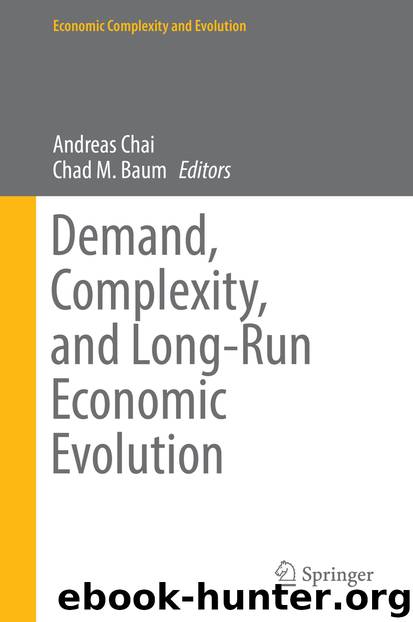Demand, Complexity, and Long-Run Economic Evolution by Andreas Chai & Chad M. Baum

Author:Andreas Chai & Chad M. Baum
Language: eng
Format: epub
ISBN: 9783030024239
Publisher: Springer International Publishing
Keywords
Demand growthConsumer learningNeedsEndogenous preferences
JEL Classifications
D11D01E21033
Reprinted by permission from Springer Nature: Springer Nature, Journal of Evolutionary Economics, Tackling Keynes’ question: a look back on 15 years of Learning To Consume, Andreas Chai, 2016.
1 Introduction
Two centuries of continuous economic growth since the industrial revolution have fundamentally transformed consumer lifestyles in Western economies and raised living standards (Lebergott 1993; De Vries 2008). As John Maynard Keynes (1933) noted in the “Economic Possibilities of our Grandchildren”, such rapid progress raises an important question: will consumption always continue to expand in the same manner as it has in the previous two centuries? If so, how? Most contemporary macroeconomic models of growth typically do not consider how economic growth influences the composition of household demand and assume that any extra income generated by increases in the productive capacity will be converted into increases in demand ad infinitum (Stiglitz 2008). In contrast, Keynes –following other scholars preceding him (i.e. Menger 1871)– considered the nature of the underlying needs that motivate consumption and how rising affluence may impact their satisfaction. He conjectured that there are two types of needs: absolute and relative needs. Absolute needs are satiable and Keynes argued that within a hundred years, these needs would be sufficiently satisfied to the extent that further energies could be devoted to non-economic purposes (Keynes 1933; Pecchi and Piga 2008). However, relative needs are insatiable because their satisfaction is linked to a desire for superiority over others.
This paper critically reviews a body of work that has adopted the Learning To Consume (LTC) approach to study the long run growth of consumption (Witt 2001; Witt 2016), Witt in this issue). By borrowing certain established insights from psychology and biology about how consumers learn and what motivates them to consume, this body of work aims to provide a more contemporary answer to Keynes’ original question. It delivers some insights into the various behavioral forces driving the long run expansion of consumption expenditure and how this process is in some ways intrinsically linked to rising social affluence and technological progress. In the existing Evolutionary Economics literature, it has already been noted how consumer learning processes can play a critical role in various aspects of economic evolution. For example, models of structural change emphasize highlight how the industrial composition of economies can respond to changes in the household composition of demand (Metcalfe et al. 2006; Bertola et al. 2006; Saviotti and Pyka 2008; Ciarli et al. 2010). They also play a role in the formation of niche markets and the degree of demand heterogeneity faced by industries (Malerba et al. 2007; Guerzoni 2010). Multi-agent models of consumer learning further highlight how they influence market dynamics (Aversi et al. 1999; Babutsidze 2011; Valente 2012). A comprehensive account of long run economic growth must consider both the character and speed at which household preferences evolve as household income grows.
Beyond growth, the LTC approach is also relevant to the ongoing question of how to promote the rapid and voluntary adoption of more environmentally sustainable (and less carbon intensive) forms of consumption (Dietz et al.
Download
This site does not store any files on its server. We only index and link to content provided by other sites. Please contact the content providers to delete copyright contents if any and email us, we'll remove relevant links or contents immediately.
International Integration of the Brazilian Economy by Elias C. Grivoyannis(99130)
The Radium Girls by Kate Moore(11976)
Turbulence by E. J. Noyes(7981)
Nudge - Improving Decisions about Health, Wealth, and Happiness by Thaler Sunstein(7659)
The Black Swan by Nassim Nicholas Taleb(7060)
Rich Dad Poor Dad by Robert T. Kiyosaki(6515)
Pioneering Portfolio Management by David F. Swensen(6259)
Man-made Catastrophes and Risk Information Concealment by Dmitry Chernov & Didier Sornette(5957)
Zero to One by Peter Thiel(5736)
Secrecy World by Jake Bernstein(4703)
Millionaire: The Philanderer, Gambler, and Duelist Who Invented Modern Finance by Janet Gleeson(4425)
The Age of Surveillance Capitalism by Shoshana Zuboff(4249)
Skin in the Game by Nassim Nicholas Taleb(4206)
Bullshit Jobs by David Graeber(4143)
The Money Culture by Michael Lewis(4136)
Skin in the Game: Hidden Asymmetries in Daily Life by Nassim Nicholas Taleb(3962)
The Dhandho Investor by Mohnish Pabrai(3727)
The Wisdom of Finance by Mihir Desai(3698)
Blockchain Basics by Daniel Drescher(3542)
